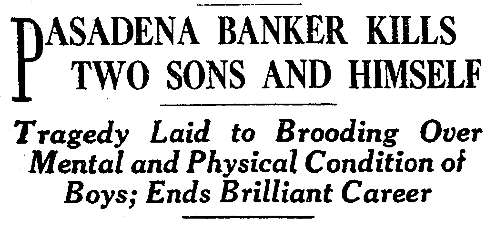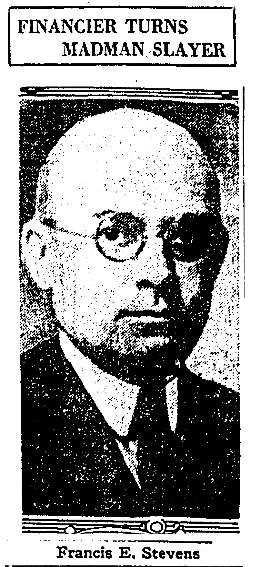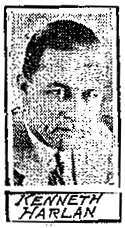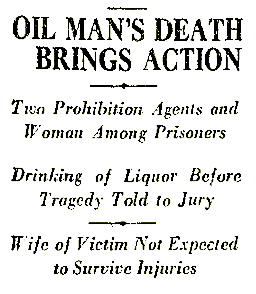
 December 8, 1927
December 8, 1927
Pasadena
The next time you need to go to a 12-step meeting, or better yet a full detox, or just be hospitalized for that durn’d dementia praecox, do yourself a favor and head on over to Las Encinas. Take in the rolling lawns, the mature trees, and gorgeous hundred year-old shingle cottages. Watch as Dr. Drew administers kindly words to one or more Osbournes, and perhaps they’ll put you in the bungalow where W. C. Fields drank and breathed his last. Then tell us if you happened upon the ghosts of Francis Stevens and his sons Georgie and Francis Jr.
Francis E. Stevens was a Prominent Pasadenan—Vice-President of the First Trust and Savings Bank of Pasadena and the First National Bank of Pasadena, member of Pasadena’s War Finance Committee, a man with a newly built home and a…lovely family.
Lovely enough, but not entirely. His wife Elizabeth was prominent socially, certainly, and of his 16 year-old daughter Carol’s charms there can be no doubt. But his sons…little George, 14, has been almost an invalid since birth, and “backward”. And as such the entirety of Francis’ hopes and expectations for the future rode on his namesake, Francis E. Jr., 20. Unfortunately, the star pupil at Univeristy of Michigan, where Francis Sr. had attended school, Francis Jr. crashed his car into a telephone pole near Ann Arbor and suffered a basal fracture that affected his mind, landing him what looked to be a permanent place back in Pasadena…at Las Encinas Sanitarium.
And so Francis Sr. did what any concerned, dutiful father would do. He went to work at eight a.m., made light and cheery conversation the cashiers, and made certain all was in order; then went home to fetch George to take him off to James A. Garfield Grammar School (once at the NE corner of S. Pasadena and California Street). This he did, and the two sat outside the school, talking in the car, until about 9:15, according to witnesses. Then they drove off, to where, we’ll never know. All we know is that Francis Sr. shot George in the head. And then arrived at Las Encinas at 10:15.
![]()
Francis left George’s corpse in the back seat covered in a laprobe, and walked to administration to inquire after his other son. He chatted with the attendants, then made his way to the bungalows. He went to the bungalow where Francis Jr. lived with his male nurse, Frank B. Schaefer, and handed Schaefer a well-wrapped package, instructing him “Don’t let anybody have these and don’t open them until you hear from me.” And with that he and his son took a lovely walk around the grounds.
 They walked and talked along the shady paths and across sun-dappled lawns until they came to the tennis court in the rear. It was 12:15 when father pulled out and brought a pistol to his son’s temple and fired. He was then seen sliding the barrel into his mouth and pulling the trigger, his body crumpling directly next to his son’s.
They walked and talked along the shady paths and across sun-dappled lawns until they came to the tennis court in the rear. It was 12:15 when father pulled out and brought a pistol to his son’s temple and fired. He was then seen sliding the barrel into his mouth and pulling the trigger, his body crumpling directly next to his son’s.
Some time after the excitement of having the wife and daughter brought to the sanitarium, and the bodies had been removed, that someone thought of having the Stevens sedan hauled away. It was only then an attendant noticed the slow moving stream of blood oozing over the fender.
The package Stevens gave to Schaefer contained securities, bonds, his will, multitudinous letters to banking concerns indicating that their finances were in order (which checked out just fine), and the ashes of Sylvia Stevens, a daughter he’d lost and cremated some time ago.
The funeral for the Stevens men was held shortly thereafter, though in spirit, the trio were still, of course, at Las Encinas.



 Central, fractured skull, concussion of the brain; J. L. Perrine, who admitted his brakes were “not so good,” drove into and off of a 400-foot embankment on Effie in the Moreno Highlands, multiple abrasions; four motorists walked away when the front half of their auto was flattened by the Los Angeles Railway car at First and Hill; and one Miss Mollie Reesor miraculously suffered only black eyes and a nasal fracture after being hurled twenty-five feet by a hit-and-run at the corner of Washington Street and Harvard Boulevard.
Central, fractured skull, concussion of the brain; J. L. Perrine, who admitted his brakes were “not so good,” drove into and off of a 400-foot embankment on Effie in the Moreno Highlands, multiple abrasions; four motorists walked away when the front half of their auto was flattened by the Los Angeles Railway car at First and Hill; and one Miss Mollie Reesor miraculously suffered only black eyes and a nasal fracture after being hurled twenty-five feet by a hit-and-run at the corner of Washington Street and Harvard Boulevard. that the woman stepped from behind a parked car near Wilshire and Tremaine. After he struck Bishop, he drove her to the office of Dr. James Johnston at Sixth and Western, where she nonetheless expired. Assuming Harlan still had time to make the benefit, his day looked like
that the woman stepped from behind a parked car near Wilshire and Tremaine. After he struck Bishop, he drove her to the office of Dr. James Johnston at Sixth and Western, where she nonetheless expired. Assuming Harlan still had time to make the benefit, his day looked like 

 Normally, drunken vehicular homicides under the auspices of Volstead-Feds get swept under the rug, but unfortunately Ingmire was former president of the
Normally, drunken vehicular homicides under the auspices of Volstead-Feds get swept under the rug, but unfortunately Ingmire was former president of the 